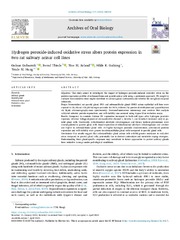Hydrogen peroxide-induced oxidative stress alters protein expression in two rat salivary acinar cell lines
Permanent link
https://hdl.handle.net/10037/36888Date
2025-04-07Type
Journal articleTidsskriftartikkel
Peer reviewed
Abstract
Design: Immortalized rat parotid gland (PG) and submandibular gland (SMG) acinar epithelial cell lines were exposed to 50 µM and 150 µM hydrogen peroxide for 24 hr, followed by protein identification and quantification via liquid chromatography-mass spectrometry. Immunofluorescence microscopy and western blot analysis validated selected protein expressions, and cell viability was assessed using trypan blue exclusion assays.
Results: Compared to controls, histone H4 expression increased in both cell types after hydrogen peroxide exposure, whereas voltage-dependent anion-selective channel 1, keratin 7, and keratin 8 increased only in parotid gland cells. Conversely, mitochondrial aldehyde dehydrogenase and kidney isoform glutaminase were downregulated in parotid gland cells. Basal expression of mitochondrial aldehyde dehydrogenase and catalase was higher in submandibular gland cells. At higher hydrogen peroxide concentrations, antioxidant proteins expression and cell viability were greater in submandibular gland cells compared to parotid gland cells.
Conclusions: Our results suggest that submandibular gland acinar cells exhibit greater resistance to oxidative stress compared to parotid gland cells, potentially due to distinct antioxidant and metabolic coping strategies. Understanding these gland-specific responses may contribute to future approaches to protect salivary glands from oxidative damage under pathological conditions.


 English
English norsk
norsk
